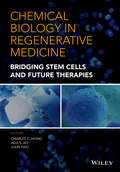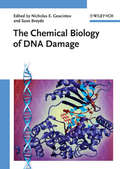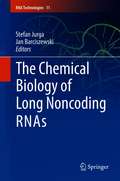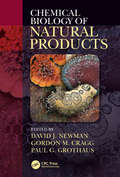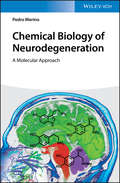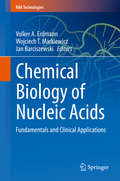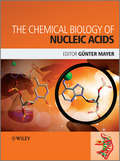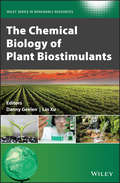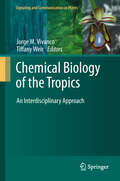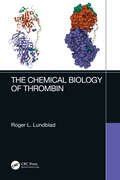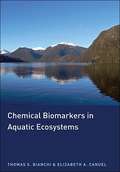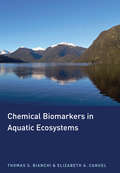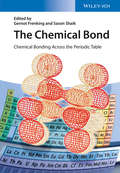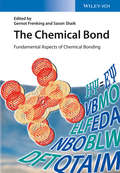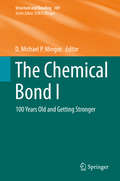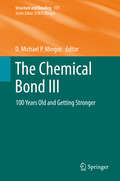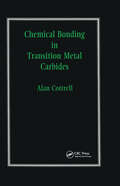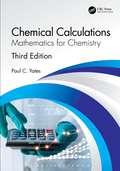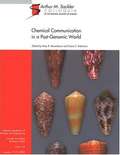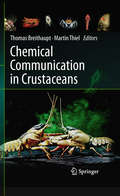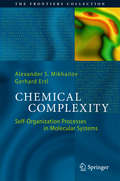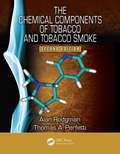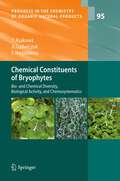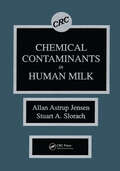- Table View
- List View
Chemical Biology in Regenerative Medicine
by Charles C. Hong Jijun Hao Ada S. AoChemical Biology in Regenerative Medicine: Bridging Stem Cells and Future Therapies The field of regenerative medicine has advanced at a rapid pace and this comprehensive summary of new developments is a timely contribution to the field as clinical trials have begun to assess the safety and efficacy of cell-based therapies. In Chemical Biology in Regenerative Medicine, an international team of experts provides an overview of progress towards clinical application in the areas of transplantation (allogenic and autologous), manipulation of niche environment and homing, and cell reprogramming (trans-differentiation and de-differentiation). The book highlights the interdisciplinary approaches undertaken to resolve current technical problems in regenerative medicine, with special attention paid to small molecules and biomaterials engineering. This volume provides an essential overview of this emerging technology for researchers in academic, industrial and clinical environments working in regenerative medicine, chemical biology, biochemistry, cell biology, biomaterials and bioengineering. It is appropriate for training students and newcomers to the field, benefitting readers in broadening their knowledge and giving them insights to regenerative chemical biology, as well as encouraging readers to implement the key points in their own fields of study to develop new technologies.
The Chemical Biology of DNA Damage
by Nicholas E. Geacintov Suse BroydeBringing the power of biochemical analysis to toxicology, this modern reference explains genotoxicity at the molecular level, showing the links between a DNA lesion and the resulting cellular or organismic response. Clearly divided into two main sections, Part 1 focuses on selected examples of important DNA lesions and their biological impact, while the second part covers current advances in assessing and predicting the genotoxic effects of chemicals, taking into account the biological responses mediated by the DNA repair, replication and transcription machineries. A ready reference for biochemists, toxicologists, molecular and cell biologists, and geneticists seeking a better understanding of the impact of chemicals on human health.
The Chemical Biology of Long Noncoding RNAs (RNA Technologies #11)
by Jan Barciszewski Stefan JurgaThis book offers a comprehensive and detailed overview of various aspects of long non-coding RNAs. It discusses their emerging significance in molecular medicine, ranging from human cancers to cardiovascular and metabolic diseases. Transcriptomic studies have demonstrated that the majority of genomes found in complex organisms are expressed in highly dynamic and cell-specific patterns, producing huge numbers of intergenic, antisense and intronic long non-protein-coding RNAs (lncRNAs). Thousands of lncRNAs have been identified, and unlike mRNA, they have no protein-coding capacity. A large repertoire of ncRNAs, actively transcribed from the mammalian genome, control diverse cellular processes, both in terms of development and diseases, through a variety of gene regulatory mechanisms. IncRNAs have emerged as a new paradigm in epigenetic regulation of the genome. Given its scope, the book will be of particular interest to molecular, chemical, cell and developmental biologists, as well as specialists in translational medicine involved in disease-oriented research. It also offers a valuable resource for in silico experts seeking a deeper understanding of lncRNA expression and function through computational analysis of the NGS data.
Chemical Biology of Natural Products
by David Newman Gordon Cragg Paul GrothausChemical Biology of Natural Products This unique, long-awaited volume is designed to address contemporary aspects of natural product chemistry and its influence on biological systems, not solely on human interactions. The subjects covered include discovery, isolation and characterization, biosynthesis, biosynthetic engineering, pharmaceutical, and other applications of these compounds. Each chapter begins with a brief and simple introduction to the subject matter, and then proceeds to guide the reader towards the more contemporary, cutting-edge research in the field, with the contributing authors presenting current examples from their own work in order to exemplify key themes. Topics covered in the text include genome mining, heterologous expression, natural product synthesis, biosynthesis, glycosylation, chemical ecology, and therapeutic applications of natural products, both current and potential.
Chemical Biology of Neurodegeneration: A Molecular Approach
by Pedro MerinoChemical Biology of Neurodegeneration
Chemical Biology of Nucleic Acids: Fundamentals and Clinical Applications (RNA Technologies)
by Jan Barciszewski Volker A. Erdmann Wojciech T. MarkiewiczThis volume contains 29 engrossing chapters contributed by worldwide, leading research groups in the field of chemical biology. Topics include pre-biology; the establishment of the genetic code; isomerization of RNA; damage of nucleobases in RNA; the dynamic structure of nucleic acids and their analogs in DNA replication, extra- and intra-cellular transport; molecular crowding by the use of ionic liquids; new technologies enabling the modification of gene expression via editing of therapeutic genes; the use of riboswitches; the modification of mRNA cap regions; new approaches to detect appropriately modified RNAs with EPR spectroscopy and the use of parallel and high-throughput techniques for the analysis of the structure and new functions of nucleic acids. This volume discusses how chemistry can add new frontiers to the field of nucleic acids in molecular medicine, biotechnology and nanotechnology and is not only an invaluable source of information to chemists, biochemists and life scientists but will also stimulate future research.
The Chemical Biology of Nucleic Acids
by Günter MayerWith extensive coverage of synthesis techniques and applications, this text describes chemical biology techniques which have gained significant impetus during the last five years. It focuses on the methods for obtaining modified and native nucleic acids, and their biological applications. Topics covered include: chemical synthesis of modified RNAexpansion of the genetic alphabet in nucleic acids by creating new base pairschemical biology of DNA replication: probing DNA polymerase selectivity mechanisms with modified nucleotidesnucleic-acid-templated chemistrychemical biology of peptide nucleic acids (PNA)the interactions of small molecules with DNA and RNAthe architectural modules of folded RNAsgenesis and biological applications of locked nucleic acid (LNA)small non-coding RNA in bacteriamicroRNA-guided gene silencingnucleic acids based therapiesinnate immune recognition of nucleic acidlight-responsive nucleic acids for the spatiotemporal control of biological processesDNA methylationframeworks for programming RNA devicesRNA as a catalyst: The Diels-Alderase-Ribozymeevolving an understanding of RNA function by in vitro approachesthe chemical biology of aptamers: synthesis and applicationsnucleic acids as detection toolsbacterial riboswitch discovery and analysisThe Chemical Biology of Nucleic Acids is an essential compendium of the synthesis of nucleic acids and their biological applications for bioorganic chemists, chemical biologists, medicinal chemists, cell biologists, and molecular biologists.
The Chemical Biology of Plant Biostimulants (Wiley Series in Renewable Resource)
by Christian V. StevensIntroduces readers to the chemical biology of plant biostimulants This book brings together different aspects of biostimulants, providing an overview of the variety of materials exploited as biostimulants, their biological activity, and agricultural applications. As different groups of biostimulants display different bioactivity and specificity, advances in biostimulant research is illustrated by different examples of biostimulants, such as humic substance, seaweed extracts, and substances with hormone-like activities. The book also reports on methods used to screen for new biostimulant compounds by exploring natural sources. Combining the expertise of internationally-renowned scientists and entrepreneurs in the area of biostimulants and biofertilisers, The Chemical Biology of Plant Biostimulants offers in-depth chapters that look at: agricultural functions and action mechanisms of plant biostimulants (PBs); plant biostimulants from seaweed; seaweed carbohydrates; and the possible role for electron shuttling capacity in elicitation of PB activity of humic substances on plant growth enhancement. The subject of auxins is covered next, followed closely by a chapter on plant biostimulants in vermicomposts. Other topics include: exploring natural resources for biostimulants; the impact of biostimulants on whole plant and cellular levels; the impact of PBs on molecular level; and the use of use of plant metabolites to mitigate stress effects in crops. Provides an insightful introduction to the subject of biostimulants Discusses biostimulant modes of actions Covers microbial biostimulatory activities and biostimulant application strategies Offers unique and varied perspectives on the subject by a team of international contributors Features summaries of publications on biostimulants and biostimulant activity The Chemical Biology of Plant Biostimulants will appeal to a wide range of readers, including scientists and agricultural practitioners looking for more knowledge about the development and application of biostimulants.
Chemical Biology of the Tropics: An Interdisciplinary Approach (Signaling and Communication in Plants #8)
by Tiffany Weir Jorge M. VivancoThe mystique of the rainforest has captured the imaginations of generations of young people, explorers, authors, and biologists. It is a delicate ecosystem whose myriad sounds and smells, whose vibrancy of life, is balanced by constant cycles of death and decay. It is a place of fierce competition where unusual partnerships are forged and creative survival strategies are the norm. In this book, you will meet the scientific pioneers who first attempted to quantify and understand the vast diversity of these tropical forests, as well as their successors, who utilize modern tools and technologies to dissect the chemical nature of rainforest interactions. This book provides a general background on biodiversity and the study of chemical ecology before moving into specific chemical examples of insect defenses and microbial communication. It finishes with first-hand accounts of the trials and tribulations of a canopy biology pioneer and a rainforest research novice, while assessing the state of modern tropical research, its importance to humanity, and the ecological, political, and ethical issues that need to be tackled in order to move the field forward.
The Chemical Biology of Thrombin
by Roger L. LundbladThis book is a comprehensive review of thrombin, especially as regulatory protease. The ready availability of highly purified thrombin has stimulated rapid advances in the cell biology of this important macromolecule. The text focuses on research findings from the discovery of thrombin by Andrew Buchanan in 1842 to the present. A substantial amount of this work was conducted by the author and his colleagues. His work on the purification of thrombin was seminal to much subsequent work on thrombin. This volume provides a framework for future studies now made possible by the discovery of the importance of exosites in the physiology of thrombin function. The current work describes the process of the development of an oral inhibitor of thrombin used in the prevention of thrombosis. Key Features Reviews the history of Thrombin (Fibrin Ferment) Documents the relation of protein engineering and chemical modification in the study of thrombin Summarizes the interaction of thrombin with fibrinogen and fibrin Outlines the role of exosites in thrombin function Describes the development of an oral inhibitor for thrombin
Chemical Biomarkers in Aquatic Ecosystems
by Thomas S. BianchiThis textbook provides a unique and thorough look at the application of chemical biomarkers to aquatic ecosystems. Defining a chemical biomarker as a compound that can be linked to particular sources of organic matter identified in the sediment record, the book indicates that the application of these biomarkers for an understanding of aquatic ecosystems consists of a biogeochemical approach that has been quite successful but underused. This book offers a wide-ranging guide to the broad diversity of these chemical biomarkers, is the first to be structured around the compounds themselves, and examines them in a connected and comprehensive way. This timely book is appropriate for advanced undergraduate and graduate students seeking training in this area; researchers in biochemistry, organic geochemistry, and biogeochemistry; researchers working on aspects of organic cycling in aquatic ecosystems; and paleoceanographers, petroleum geologists, and ecologists. Provides a guide to the broad diversity of chemical biomarkers in aquatic environmentsThe first textbook to be structured around the compounds themselvesDescribes the structure, biochemical synthesis, analysis, and reactivity of each class of biomarkersOffers a selection of relevant applications to aquatic systems, including lakes, rivers, estuaries, oceans, and paleoenvironmentsDemonstrates the utility of using organic molecules as tracers of processes occurring in aquatic ecosystems, both modern and ancient
Chemical Biomarkers in Aquatic Ecosystems
by Elizabeth A. Canuel Thomas S. BianchiThis textbook provides a unique and thorough look at the application of chemical biomarkers to aquatic ecosystems. Defining a chemical biomarker as a compound that can be linked to particular sources of organic matter identified in the sediment record, the book indicates that the application of these biomarkers for an understanding of aquatic ecosystems consists of a biogeochemical approach that has been quite successful but underused. This book offers a wide-ranging guide to the broad diversity of these chemical biomarkers, is the first to be structured around the compounds themselves, and examines them in a connected and comprehensive way. This timely book is appropriate for advanced undergraduate and graduate students seeking training in this area; researchers in biochemistry, organic geochemistry, and biogeochemistry; researchers working on aspects of organic cycling in aquatic ecosystems; and paleoceanographers, petroleum geologists, and ecologists. Provides a guide to the broad diversity of chemical biomarkers in aquatic environments The first textbook to be structured around the compounds themselves Describes the structure, biochemical synthesis, analysis, and reactivity of each class of biomarkers Offers a selection of relevant applications to aquatic systems, including lakes, rivers, estuaries, oceans, and paleoenvironments Demonstrates the utility of using organic molecules as tracers of processes occurring in aquatic ecosystems, both modern and ancient
The Chemical Bond: Chemical Bonding Across the Periodic Table
by Sason Shaik Gernot FrenkingA unique overview of the different kinds of chemical bonds that can be found in the periodic table, from the main-group elements to transition elements, lanthanides and actinides. It takes into account the many developments that have taken place in the field over the past few decades due to the rapid advances in quantum chemical models and faster computers. This is the perfect complement to "Chemical Bonding - Fundamentals and Models" by the same editors, who are two of the top scientists working on this topic, each with extensive experience and important connections within the community.
The Chemical Bond - Fundamental Aspects of Chemical Bonding
by Gernot Frenking Sason ShaikThis is the perfect complement to "Chemical Bonding - Across the Periodic Table" by the same editors, who are two of the top scientists working on this topic, each with extensive experience and important connections within the community.The resulting book is a unique overview of the different approaches used for describing a chemical bond, including molecular-orbital based, valence-bond based, ELF, AIM and density-functional based methods. It takes into account the many developments that have taken place in the field over the past few decades due to the rapid advances in quantum chemical models and faster computers.
The Chemical Bond I
by D. Michael P. MingosThe series Structure and Bonding publishes critical reviews on topics of research concerned with chemical structure and bonding. The scope of the series spans the entire Periodic Table and addresses structure and bonding issues associated with all of the elements. It also focuses attention on new and developing areas of modern structural and theoretical chemistry such as nanostructures, molecular electronics, designed molecular solids, surfaces, metal clusters and supramolecular structures. Physical and spectroscopic techniques used to determine, examine and model structures fall within the purview of Structure and Bonding to the extent that the focus is on the scientific results obtained and not on specialist information concerning the techniques themselves. Issues associated with the development of bonding models and generalizations that illuminate the reactivity pathways and rates of chemical processes are also relevant. The individual volumes in the series are thematic. The goal of each volume is to give the reader, whether at a university or in industry, a comprehensive overview of an area where new insights are emerging that are of interest to a larger scientific audience. Thus each review within the volume critically surveys one aspect of that topic and places it within the context of the volume as a whole. The most significant developments of the last 5 to 10 years should be presented using selected examples to illustrate the principles discussed. A description of the physical basis of the experimental techniques that have been used to provide the primary data may also be appropriate, if it has not been covered in detail elsewhere. The coverage need not be exhaustive in data, but should rather be conceptual, concentrating on the new principles being developed that will allow the reader, who is not a specialist in the area covered, to understand the data presented. Discussion of possible future research directions in the area is welcomed. Review articles for the individual volumes are invited by the volume editors
The Chemical Bond II
by D. Michael P. MingosThe series Structure and Bonding publishes critical reviews on topics of research concerned with chemical structure and bonding. The scope of the series spans the entire Periodic Table and addresses structure and bonding issues associated with all of the elements. It also focuses attention on new and developing areas of modern structural and theoretical chemistry such as nanostructures, molecular electronics, designed molecular solids, surfaces, metal clusters and supramolecular structures. Physical and spectroscopic techniques used to determine, examine and model structures fall within the purview of Structure and Bonding to the extent that the focus is on the scientific results obtained and not on specialist information concerning the techniques themselves. Issues associated with the development of bonding models and generalizations that illuminate the reactivity pathways and rates of chemical processes are also relevant. The individual volumes in the series are thematic. The goal of each volume is to give the reader, whether at a university or in industry, a comprehensive overview of an area where new insights are emerging that are of interest to a larger scientific audience. Thus each review within the volume critically surveys one aspect of that topic and places it within the context of the volume as a whole. The most significant developments of the last 5 to 10 years should be presented using selected examples to illustrate the principles discussed. A description of the physical basis of the experimental techniques that have been used to provide the primary data may also be appropriate, if it has not been covered in detail elsewhere. The coverage need not be exhaustive in data, but should rather be conceptual, concentrating on the new principles being developed that will allow the reader, who is not a specialist in the area covered, to understand the data presented. Discussion of possible future research directions in the area is welcomed. Review articles for the individual volumes are invited by the volume editors
The Chemical Bond III
by D. Michael P. MingosThe series Structure and Bonding publishes critical reviews on topics of research concerned with chemical structure and bonding. The scope of the series spans the entire Periodic Table and addresses structure and bonding issues associated with all of the elements. It also focuses attention on new and developing areas of modern structural and theoretical chemistry such as nanostructures, molecular electronics, designed molecular solids, surfaces, metal clusters and supramolecular structures. Physical and spectroscopic techniques used to determine, examine and model structures fall within the purview of Structure and Bonding to the extent that the focus is on the scientific results obtained and not on specialist information concerning the techniques themselves. Issues associated with the development of bonding models and generalizations that illuminate the reactivity pathways and rates of chemical processes are also relevant. The individual volumes in the series are thematic. The goal of each volume is to give the reader, whether at a university or in industry, a comprehensive overview of an area where new insights are emerging that are of interest to a larger scientific audience. Thus each review within the volume critically surveys one aspect of that topic and places it within the context of the volume as a whole. The most significant developments of the last 5 to 10 years should be presented using selected examples to illustrate the principles discussed. A description of the physical basis of the experimental techniques that have been used to provide the primary data may also be appropriate, if it has not been covered in detail elsewhere. The coverage need not be exhaustive in data, but should rather be conceptual, concentrating on the new principles being developed that will allow the reader, who is not a specialist in the area covered, to understand the data presented. Discussion of possible future research directions in the area is welcomed. Review articles for the individual volumes are invited by the volume editors
Chemical Bonding in Transition Metal Carbides
by Sir Alan CottrellThis book presents a mainly qualitative understanding of this family of materials which ranges from simple NaCl type compounds to complex chromium carbides.
Chemical Calculations: Mathematics for Chemistry, Third Edition
by Paul C. YatesUniquely organized by chemical rather than mathematical topics, this book relates each mathematical technique to the chemical concepts where it applies. The new edition features additional, revised, and updated material in every chapter, and maintains the clarity of the previous edition with appropriate organization of topics and improved cross-referencing where mathematical techniques occur more than once. The text contains additional worked examples and end-of-chapter exercises with detailed solutions—giving students the opportunity to apply previously introduced techniques to chemically related problems. An ideal course companion for chemistry courses throughout the length of a degree. Features This book covers the difficult area of mathematics in an easy-to-read format for students and professionals in chemistry and related subjects Structured according to chemical rather than mathematical topics Each topic has 10 end of chapter applied chemistry problems to provide practice in applying the techniques to real chemistry Indexing of material by both chemical and mathematical topics Extends its utility as a concise and practical reference for professionals in a wide array of scientific disciplines involving chemistry
Chemical Communication in a Post-Genomic World
by National Academies of Sciences EngineeringOne major goal of post-genomic biology is to understand the function of genes. Many gene functions are comprehensible only within the context of chemical communication, and this symposium seeks to highlight emerging research on genomics and chemical communication and catalyze further development of this highly productive interface. Many of the most abundantly represented genes in the genomes characterized to date encode proteins mediating interactions among organisms, including odorant receptors and binding proteins, enzymes involved in biosynthesis of pheromones and toxins, and enzymes catalyzing the detoxification of defense compounds. Determining the molecular underpinnings of the component elements of chemical communication systems in all of their forms has the potential to explain a vast array of ecological, physiological, and evolutionary phenomena; by the same token, ecologists who elucidate the environmental challenges faced by the organisms are uniquely well-equipped to characterize natural ligands for receptors and substrates for enzymes. Thus, partnerships between genome biologists and chemical ecologists will likely be extremely synergistic. To date, these groups have rarely had opportunities to interact within a single forum. Such interactions are vital given the considerable practical benefits potentially stemming from these studies, including the development of biorational products for agricultural and forest pest management, for disease treatment, and for improving the quality of ecosystem health.
Chemical Communication in Crustaceans
by Thomas Breithaupt Martin ThielThe crustaceans are ecologically and economically important organisms. They constitute one of the dominant invertebrate groups on earth, particularly within the aquatic realm. Crustaceans include some of the preferred scientific model organism, profitable aquaculture specimen, but also invasive nuisance species threatening native animal communities throughout the world. Chemoreception is the most important sensory modality of crustaceans, acquiring important information about their environment and picking up the chemical signals that mediate communication with conspecifics. Significant advances have been made in our understanding of crustacean chemical communication during the past decade. This includes knowledge about the identity, production, transfer, reception and behavioral function of chemical signals in selected crustacean groups. While it is well known that chemical communication is an integral part of the behavioral ecology of most living organisms, the intricate ways in which organisms allocate chemicals in communication remains enigmatic. How does the environment influence the evolution of chemical communication? What are the environmental cues that induce production or release of chemicals? How do individuals economize production and utilization of chemicals? What is the importance of molecule specificity or mix of a molecule cocktail in chemical communication? What is the role of chemical cues in multimodal communication? How does the ontogenetic stage, the sex or the physiological status of an individual affect its reaction to chemical cues? Many of these questions still represent important challenges to biologists.
Chemical Complexity: Self-Organization Processes in Molecular Systems (The Frontiers Collection)
by Alexander S. Mikhailov Gerhard ErtlThis review volume, co-edited by Nobel laureate G Ertl, provides a broad overview on current studies in the understanding of design and control of complex chemical systems of various origins, on scales ranging from single molecules and nano-phenomena to macroscopic chemical reactors. Self-organizational behavior and the emergence of coherent collective dynamics in reaction–diffusion systems, reactive soft matter and chemical networks are covered. Special attention is paid to the applications in molecular cell biology and to the problems of biological evolution, synthetic biology and design of artificial living cells. Starting with a detailed introduction on the history of research on complex chemical systems, its current state of the art and perspectives, the book comprises 19 chapters that survey the current progress in particular research fields. The reviews, prepared by leading international experts, yield together a fascinating picture of a rapidly developing research discipline that brings chemical engineering to new frontiers. Contents: "Introduction: "Analysis, Design and Control of Complex Chemical Systems "(Alexander S Mikhailov and Gerhard Ertl)""Single Molecules, Nanoscale Phenomena and Active Particles: "Imaging and Manipulation of Single Molecules by Scanning Tunneling Microscopy "(Leonhard Grill)"Self-Organization at the Nanoscale in Far-From-Equilibrium Surface Reactions and Copolymerizations "(Pierre Gaspard)"Single Molecule and Collective Dynamics of Motor Protein Coupled with Mechano-Sensitive Chemical Reaction "(Mitsuhiro Iwaki, Lorenzo Marcucci, Yuichi Togashi and Toshio Yanagida)"Nanomotors Propelled by Chemical Reactions "(Raymond Kapral)"Biology of Nanobots "(Wentao Duan, Ryan Pavlick and Ayusman Sen)""Reaction–Diffusion Systems and Nonequilibrium Soft Matter: "Wave Phenomena in Reaction–Diffusion Systems "(Oliver Steinbock and Harald Engel)"Self-Oscillating Polymer Gels as Smart Materials "(Ryo Yoshida)"Stochastic Fluctuations and Spontaneous Symmetry Breaking in the Chemotaxis Signaling System of "Dicyostelium" Cells "(Tatsuo Shibata)"Mechanochemical Pattern Formation in the Polarization of the One-Cell "C Elegans" Embryo "(Justin S Bois and Stephan W Grill)""Oscillations and Synchronization: "Synchronization of Electrochemical Oscillators "(Mahesh Wickramasinghe and István Z Kiss)"Turbulence and Synchrony in Spatially Extended Electrochemical Oscillators "(Vladimir Garcia-Morales and Katharina Krischer)"Quorum Sensing and Synchronization in Populations of Coupled Chemical Oscillators "(Annette F Taylor, Mark R Tinsley and Kenneth Showalter)"Collective Decision-Making and Oscillatory Behaviors in Cell Populations "(Koichi Fujimoto and Satoshi Sawai)"Synchronization via Hydrodynamic Interactions "(Franziska Kendelbacher and Holger Stark)""Evolution, Synthetic Biology, and Protocells: "Emergence and Selection of Biomodules: Steps in the Assembly of a Protocell "(Susanna C Manrubia and Carlos Briones)"From Catalytic Reaction Networks to Protocells "(Kunihiko Kaneko)"Constructive Approach Towards Protocells "(Tadashi Sugawara, Kensuke Kurihara and Kentaro Suzuki)"Network Reverse Engineering Approach in Synthetic Biology "(Haoqian Zhang, Ao Liu, Yuheng Lu, Ying Sheng, Qianzhu Wu, Zhenzhen Yin, Yiwei Chen, Zairan Liu, Heng Pan and Qi Ouyang)"Readership: Graduate students and scientists interested in complex chemical systems.
The Chemical Components of Tobacco and Tobacco Smoke
by Alan Rodgman Thomas A. PerfettiAuthored by two longtime researchers in tobacco science, The Chemical Components of Tobacco and Tobacco Smoke, Second Edition chronicles the progress made from late 2008 through 2011 by scientists in the field of tobacco science. The book examines the isolation and characterization of each component. It explores developments in pertinent analytical
Chemical Constituents of Bryophytes: Bio- and Chemical Diversity, Biological Activity, and Chemosystematics (Progress in the Chemistry of Organic Natural Products #95)
by A. Douglas Kinghorn Heinz Falk Junichi Kobayashi Agnieszka Ludwiczuk Fumihiro Nagashima Yoshinori AsakawaFor some 50 years, Professor Asakawa and his group have focused their research on the chemical constituents of bryophytes and have found that these plants contain large numbers of secondary metabolites, such as terpenoids, acetogenins, and aromatic compounds representative of many new skeletons, which exhibit interesting biological activities. Individual terpenoids, when found as constituents of both a bryophyte and a higher plant, tend to occur in different enantiomeric forms. Professor Asakawa has covered the literature on bryophytes in two earlier volumes of Progress in the Chemistry of Organic Natural Products, namely, Volumes 42 (1982) and 65 (1995). Since the publication of the latter volume, a great deal of new information has appeared on bryophytes. One example is that known sex pheromones of algae have been discovered in two liverworts, indicating that some members of the latter taxonomic group might originate from brown algae. From information provided in this volume, it is suggested that two orders of the Marchantiophyta should be combined.
Chemical Contaminants in Human Milk
by Allan Astrup Jensen Stuart A. SlorachChemical Contaminants in Human Milk contains a comprehensive, up-to-date global review of the contamination of human milk with environmental and occupational chemicals. The book covers many different aspects of this problem, including the extent and benefits of breast-feeding, the transfer of chemicals into breast milk, analytical methodologies used in human milk studies, the levels of chemical contaminants in human milk, and geographical variations and time trends in levels. The many different factors that can influence the levels of contaminants in breast milk are also discussed. Other important topics examined include human milk contamination due to exposure of the mother at the workplace and the risk to her baby, the intake of toxic chemicals by breast-fed infants, calculated intakes and official limit values, the toxicological implications of human milk contamination based on available data from animal experiments and human studies. The book concludes with an overall assessment of the current situation, together with recommendations for future work. Chemical Contaminants in Human Milk is a valuable source of information for pediatricians and other health professionals, policy makers involved with ensuring the health and welfare of infants and nursing mothers, nursing mothers and organizations involved in the promotion of breast feeding, and individuals and organizations involved with the study and control of environmental pollution and occupational hygiene.
